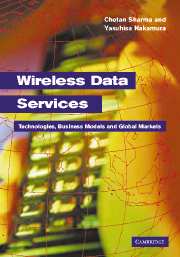Book contents
- Frontmatter
- Contents
- List of figures
- About the authors
- Foreword
- Acknowledgements
- List of abbreviations
- 1 Introduction
- 2 The impact of globalization
- 3 Adoption trends and analysis by region
- 4 Subscriber needs and expectations
- 5 The wireless value chain
- 6 Global wireless technologies: systems and architectures
- 7 Global wireless technologies: network, access, and software
- 8 Business models and strategies
- 9 Business issues and challenges
- 10 Technology issues and challenges
- 11 Case studies
- 12 Perspectives
- 13 Future of wireless technologies, applications and services
- 14 Conclusions and recommendations
- References and recommended reading
- Index
11 - Case studies
Published online by Cambridge University Press: 06 August 2009
- Frontmatter
- Contents
- List of figures
- About the authors
- Foreword
- Acknowledgements
- List of abbreviations
- 1 Introduction
- 2 The impact of globalization
- 3 Adoption trends and analysis by region
- 4 Subscriber needs and expectations
- 5 The wireless value chain
- 6 Global wireless technologies: systems and architectures
- 7 Global wireless technologies: network, access, and software
- 8 Business models and strategies
- 9 Business issues and challenges
- 10 Technology issues and challenges
- 11 Case studies
- 12 Perspectives
- 13 Future of wireless technologies, applications and services
- 14 Conclusions and recommendations
- References and recommended reading
- Index
Summary
In the past two chapters, we focused our attention on issues and challenges facing our industry. In this chapter, we will discuss four unique case studies that show how wireless technology can be used to enhance productivity, improve revenues, or gain mindshare.
Southern Wines and Spirits
Problem description
Like a lot of industries, the wines and spirits industry is in the midst of consolidation. Distributors are searching for ways to cut costs while maintaining customer relationships crucial to increasing market share and revenue. Southern Wines and Spirits of California Inc. (SWS), the single largest distributor of wine, spirits, beer and other non-alcoholic beverages in the USA, saw an opportunity to save by automating its sales processes. Five thousand reps in the field were generating half a million sheets of paperwork per week. They placed orders in a “Brick” that sent data back to the home office through a 300 bps (remember, that is bits per second) acoustic coupler. The error rate was high, and delays in orders were an all too common occurrence. This information was fed into the enterprise system, a group of about five IBM AS/400® servers and an IBM S/390 enterprise server.
How wireless was used to solve the problem
“We knew there had to be a better way,” said Steve Borrows, VP of Spirits at SWS, which represents more than 300 suppliers and nearly 6000 individual brands. “Once information came into our systems we had applications that worked.
- Type
- Chapter
- Information
- Wireless Data ServicesTechnologies, Business Models and Global Markets, pp. 252 - 261Publisher: Cambridge University PressPrint publication year: 2003



